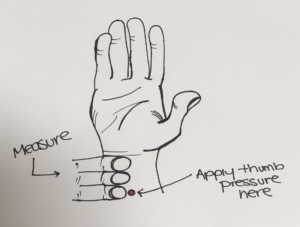Free yourself from pain with these 5 tips!
5 tips on how to relieve pain naturally
No one likes pain. Yet many of us live with it daily, accepting there is nothing we can do. There are solutions that are quick, effective and have little to no side-effects.
Dr. Mason-Wood is a Doctor of Naturopathic Medicine at Natural Terrain Naturopathic Clinic and specializes in pain management.
The reason why Naturopathic Medicine is so effective at treating health issues is because they are your best and biggest health advocate. They work with patients to develop treatment plans that fit their health goals. As well, they pin-point the cause of health issues. You wouldn’t want to fix a fence by painting it, right? You would want to look at the foundation, the source of the problem and then address it accordingly.
1. Learn to deep breathe and meditate.
Various studies have demonstrated that perception of pain can be significantly reduced by mindful meditation sessions that help calm the nervous system.
Try this simple meditation:
- Find a comfortable position with your back upright and hands resting where they feel relaxed. Put the tongue to the roof of your mouth.
- Try to become as relaxed as possible. Feel the sensations of your body and relax areas of tightness. Breathe through your nose.
- Begin to tune into your breath. Feel the natural flow of air, in and out. Try to feel where one breath begins and the other ends – steadily slowing down your breath when it feels right while bringing your breath down to your abdomen. It is important that you match the rhythm of your in breath to your out breath.

- Try to focus on only your breath. When your mind wanders, try to continuously bring it back to your breath and the present moment.
- Continue for at least 5 minutes. When you feel lost in your thoughts, come back to only your breath. Repeat this exercise daily for added health benefits.
2. Use positive affirmations.
These are affirmations that you can say to yourself to help relax. Acknowledge that you are afraid, but you are not actually in danger. For example “I’m okay, this is my fear of needles but I have the power to get over it!”
3. Try acupressure.
An ancient Chinese healing method that involves applying pressure with the fingers or hands on certain points of the body. Acupressure can be used to reduce anxiety and stress prior to needle injections.
Some pressure points to use on your own:
PC 6: Measure down with three fingers from your wrist. Where your third finger touches the middle of your wrist is the acupuncture point know as PC6. Take your thumb and apply firm pressure to this point until you feel mild discomfort. Only apply enough pressure to interrupt the normal blood flow but not too much that it causes pain. Hold this pressure point and gently knead your thumb in a tight circular motion for about 2 minutes. Do this to both wrists and you will feel a reduction in anxiety.
Ears: Gently massage your ears with your thumb and forefinger. There is no exact pressure point, simply give yourself a relaxing ear massage. Pull down gently on the lobes and rub the inner surface of the ear for about 2 minutes.
4. Reward yourself.
If you managed to successfully get an injection that you would have normally missed due to fear, reward yourself! You will begin to associate the needle with a positive reward, not with pain or fear.
5. Do your research.
Learn more about injection treatments and considering the benefits that you will achieve from this form of therapy as they definitely outweigh a small needle prick.
- Injection therapies involve the injection of various substances (such as homeopathics, ozone, procaine and dextrose) into areas of pain. This promotes a localized response that activates the immune system and other body systems to repair and rebuild areas that are damaged. This is the most common treatment used in pain management at Natural Terrain and we see it completely change patients’ lives. There are numerous injection therapies that can be performed as part of a pain management program such as: prolotherapy, PRP therapy, prolozone therapy, biopuncture, neural therapy, and many others.
- Prolotherapy is also known as “nonsurgical ligament reconstruction” and is a treatment for chronic musculoskeletal pain. The word “Prolo” is short for proliferation as Prolotherapy treatment enhances the growth and formation of new ligaments, tendons and cartilage in areas where there is weakness or excess scar tissue.
- Prolozone therapy is a non-surgical reconstructive treatment for ligament and joint damage.
- Biopuncture is a natural therapy that involves the injection of dilute botanical and homeopathic substances into areas of acute or chronic pain to stimulate the natural healing response of the body. The injections are done at very specific areas of pain and inflammation to promote a local immune response that stimulates the body’s innate ability to heal itself.
- Neural therapy is a simple, safe injection therapy which balances the central nervous system (CNS); specifically the autonomic nervous system. The CNS controls the entire body and disturbances of it can affect all other bodily systems. These body systems include: breathing, heart rate, body temperature, circulation, digestion, lymphatic and every other bodily function.
Common conditions treated with injection therapies:
- Neck pain
- Back pain
- Sciatica
- Ankle pain
- Shoulder pain
- Tendinitis
- Sprains & Strains
- Joint pain
- Nerve pain
- Arthritis
- Fibromyalgia
- Female gynaecological complaints
- Shingles
- Migraines
- Irritable bowel syndrome
Are you afraid of needles?
That fear may be the barrier against healing chronic pain. For most people, a little needle doesn’t seem so bad – but for 20% of the population needle fear is a big problem. Those who are afraid of needles can benefit by learning how to manage their emotional states toward injections and move past their fears in order to live pain-free!
Why are needles so frightening?
We are naturally selected to protect ourselves against danger associated with bodily harm. Our brains help us by responding to harmful situations through escape. We are programmed to do so because evolution has allowed anything that threatens our safety and health to increase activation in our amygdala; a region of the brain important in emotional reaction, decision-making, and memory.
If you felt fear or anxiety from a needle the last time you experienced it, it’s likely that you experienced a heightened-state of awareness and activation of memory formation in the amygdala.
This explains why you may have a strong association with needles and fear. Your fear is not irrational; it is simply human nature at its best! The question is can we find a way to override this evolutionary response? Absolutely, yes!
How can we override this fear response?
Before explaining how we can change our response to needle fear, it is important to give some background information on our response to pain and why we are in more control of it than we may have thought. The gate control theory of pain demonstrates how signals from pain receptors are controlled in two directions – one from the spinal cord/pain receptors toward the brain AND to our benefit, one from the brain down to the spinal cord. Through activating inhibitory fibers from the brain acting on pain neurons – emotional states and thoughts can really impact our perception of pain.
Often this is why those who are focused on an activity, like an intense basketball game, do not feel the pain of an ankle sprain until after the game. On the other hand, people who are anxious focus on the pain and find it difficult to cope. Our brain sends messages through descending fibers that can actually reduce or amplify the transmission of pain signals through the gate, depending on the thoughts and emotional state of the person.
By calming our emotions or focusing on something other than the injection, we dampen our sensation of pain and may not even feel anything at all!
References:
http://www.spine-health.com/blog/mindful-meditation-vs-chronic-pain
http://www.spine-health.com/conditions/chronic-pain/gate-control-theory-chronic-pain-action
http://thebrain.mcgill.ca/flash/d/d_04/d_04_cr/d_04_cr_peu/d_04_cr_peu.html
http://www.mindful.org/a-five-minute-breathing-meditation/
http://www.finebalanceacupuncture.com/2011/04/acupressure-for-instant-anxiety-relief/



